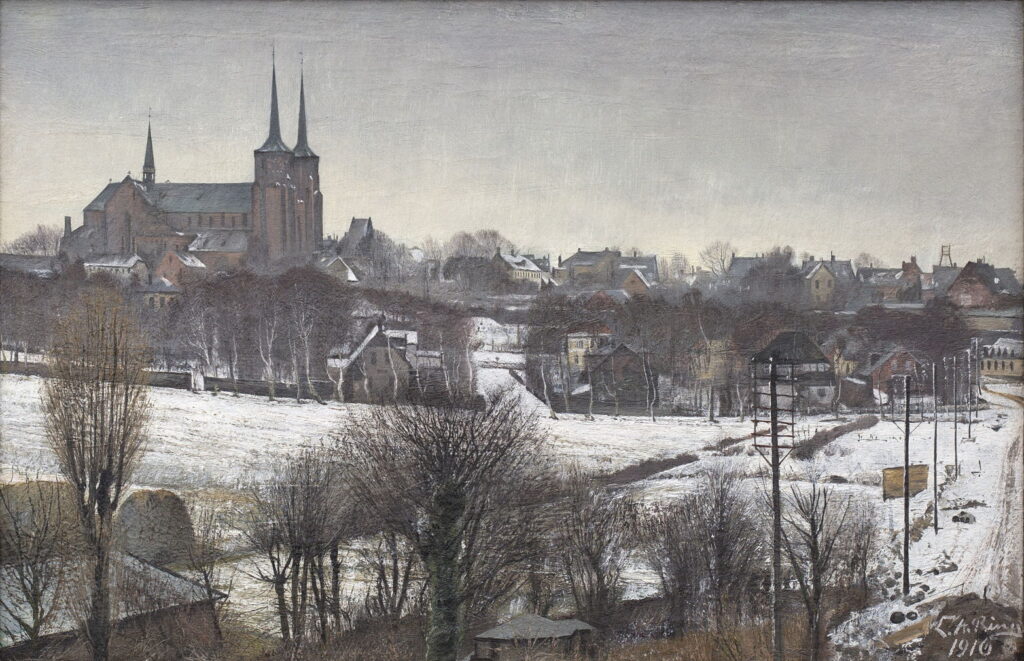Paintings of the Danish countryside: Zealand 2

This is the second of two articles looking at paintings of the Zealand countryside from the early nineteenth century up to the 1930s. I have reached the start of the twentieth century, and proceed with the landscapes of the two Andersens, Laurits Andersen Ring and Hans Andersen Brendekilde.
Laurits Andersen Ring (1854–1933), By the Village Pond at Baldersbrønde (1911), oil on canvas, 50 x 63 cm, Private collection. Wikimedia Commons.
After LA Ring married Sigrid, daughter of the ceramicist Herman Kähler, the family settled in the village of Baldersbrønde, midway between what’s now the western edge of Copenhagen’s conurbation, and the city of Roskilde, on Zealand. By the Village Pond at Baldersbrønde from 1911 shows this village with its rutted mud track, in early Spring when the pollards are still bare of leaves.
The other painting Andersen of the day was LA Ring’s friend and contemporary originally named Hans Andersen, who adopted the surname of Brendekilde after the village of Brændekilde, on the island of Funen (Fyn), where he was born.
Hans Andersen Brendekilde (1857–1942), A Sower on a Sunny Spring Day at Brendekilde Church (1914), oil on canvas, 49 x 76 cm, Private collection. Wikimedia Commons.
Brendekilde’s A Sower on a Sunny Spring Day at Brendekilde Church from 1914 shows Holme-Olstrup Church, near Næstved on Zealand. The sower, walking over poor soil with abundant stones, has been identified as Ole Frederik Jensen (1870-1953).
LA Ring later moved to the tiny rural island of Enø, linked to Zealand by a bridge at Karrebæksminde.
Laurits Andersen Ring (1854–1933), The Bridge at Karrebæksminde (1912), oil on canvas, 69.5 x 132 cm, Statsministeriet, Copenhagen, Denmark. Wikimedia Commons.
The Bridge at Karrebæksminde from 1912 must be one of Ring’s most intricately detailed works, showing the bridge connecting the large and populous island of Zealand with tiny Enø. This canal was dug in the early nineteenth century to connect Karrebæk Fjord with the waters of the Baltic, and has a strong tidal stream, as demonstrated here.
Laurits Andersen Ring (1854–1933), The Artist’s Wife with the Family Caravan (1911), oil on canvas, 39.5 x 60.5 cm, Statsministeriet, Copenhagen, Denmark. Wikimedia Commons.
By 1911, LA Ring and his family had bought a caravan, which in those days resembled a railway goods wagon and usually weighed several tons. Most had to be towed by a truck or one of the traction engines still used on farms, and were barely mobile. The Artist’s Wife with the Family Caravan (1911) shows his wife Sigrid in a loose-fitting dress, under the shade of a parasol, enjoying a holiday amid sand dunes, somewhere on the Danish Baltic coast.
Laurits Andersen Ring (1854–1933), View of a Shore with the Artist’s Wagon and Tent at Enö (1913), oil on canvas, 40 x 61 cm, Nationalmuseum, Stockholm, Sweden. Wikimedia Commons.
In the summer of 1913 Ring and his family holidayed again in their caravan. In his View of a Shore with the Artist’s Wagon and Tent at Enö, they are seen on the south-west coast of the island of Enø. They have spilled out into a tent, whose heavy guy ropes are being used to dry washing.
After the start of the First World War, LA Ring retired to a house built for him near the city of Roskilde, in the centre of Zealand. This was ideally situated in what was then the neighbouring village of Sankt Jørgensbjerg. Although generally flat and low country, the land rises to 40 metres (130 feet) above the water of Roskilde Fjord. Ring’s house and environs gave him fine views over the city, country, and the fjord itself to the north, that dominated his paintings during the final eighteen years of his life.
Laurits Andersen Ring (1854–1933), View of Roskilde from Sankt Jørgensbjerg (1916), oil on canvas, 41 x 62.5 cm, Statsministeriet, Copenhagen, Denmark. Wikimedia Commons.
In the winter of 1916 he painted one of his finest landscapes, View of Roskilde from Sankt Jørgensbjerg. It’s a dull grey day, with the snow still lying on the ground. Although distant, the great cathedral dominates from its position at the top of the hill. In seemingly painting every single branch and twig on the barren trees, Ring has brought a fine, rhythmic texture to the foreground that extends right to the skyline. The detail below shows his rich vocabulary of textures in the trees, field, and buildings, which compensate for the muted colours.
Laurits Andersen Ring (1854–1933), View of Roskilde from Sankt Jørgensbjerg (detail) (1916), oil on canvas, 41 x 62.5 cm, Statsministeriet, Copenhagen, Denmark. Wikimedia Commons.
Laurits Andersen Ring (1854–1933), Spring Day at Køge (1931), oil on canvas, 20 x 32 cm, Statsministeriet, Copenhagen, Denmark. Wikimedia Commons.
Spring Day at Køge from 1931 was painted at this town to the south of Roskilde, on the coast opposite southern Sweden.
Laurits Andersen Ring (1854–1933), A View Over the Roofs at Sankt Jørgensbjerg, Denmark (1932), oil on canvas, 27 x 37 cm, location not known. Wikimedia Commons.
One of the last of LA Ring’s landscapes shows this View Over the Roofs at Sankt Jørgensbjerg, Denmark, from 1932. By this time, he was 78, still a superb artist with great precision in his detail of the leafless trees, and in the texture of the thatch. The church behind the trees is that of Sankt Jørgensbjerg, and this view is from the artist’s house.



